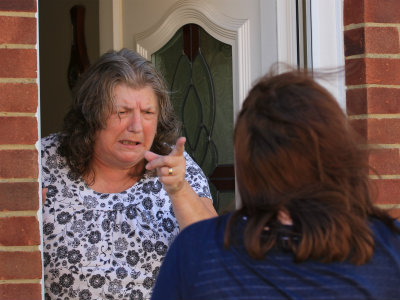
Sponsored by:
Editorial content is independent of the sponsor
Social care staff who experience violence on the job are as likely to be attacked in their offices as they are in a service user’s home, research by Community Care has revealed.
For the third year in a row, nine in 10 respondents to our survey say they have been abused, assaulted or threatened with violence while working in social care. The majority of those (80%) have been attacked two or more times over the past year. As in previous years, the threats and abuse were mostly verbal, but 39% of social care workers said they had been the victims of physical violence.
How violent is your area? Find out using our interactive map
Most of those who had been attacked said the perpetrator was a service user (80%), followed by a service user’s friend or relative (40%, taking into account the fact that some social care workers will have experienced violence from both groups). Violence is as likely to occur in the office as in the service user’s home.
This year’s investigation, in conjunction with Unison, also reveals that rates of violence tend to be higher against care staff than qualified social workers.
Data collected for the financial year 2012-13 showed that one violent incident was recorded per every 28 social workers employed, compared to one incident per every six care workers. Not all local authorities recorded separate data for social workers and other care staff, so more research may be needed.
There also appeared to be proportionately more attacks in adult services, with one incident recorded per eight workers compared to one in 10 for children’s services. However, there is no way of knowing whether individuals recorded more than one incident.
Sixty-five of the social care workers surveyed told us they have been attacked with an object during the course of their work. Find out what they were attacked with here.
On a more positive note, the research points towards a fall in average number of violent incidents against social care staff per local authority, from 147 in 2010-11 and 153 in 2011-12 to 139 in 2012-13. The number of incidents recorded per council can be seen on our interactive map.
However, our map also shows that many local authorities do not record violence against social care staff (where there is no colour) or are unable to provide comparable data.
“Once again we see that many councils are failing to even record incidents properly,” said Helga Pile, Unison’s national officer for social care. “How can we have any confidence that there is a systematic and sustainable effort to bring down violent incidents?
“This problem is a running sore in social care affecting staff morale, recruitment, retention and the quality of services. In this era of closer integration with health the difference in approach to violence against staff between social care and the NHS will stand out more than ever. It needs concerted, co-ordinated national leadership to guide and drive local action.
“Any suggestion that the number of incidents is falling would be welcome, but we have to view this with caution as it could just reflect falling staff numbers in social care caused by job losses and privatisation.”
Only around half (53%) of the 170 social care workers who said they had experienced violence had reported it to their manager. Of those, almost two-thirds (62%) said their manager did not take any steps to investigate the incident. “Social work managers must be prepared to put appropriate safeguards in place, even when this has resource implications,” said Annie Hudson, chief executive of the College of Social Work.
Hudson also called for better training to help practitioners identify and respond safely to risky situations. More than a third of respondents to our survey (39%) said they had never received formal training on how to cope with violent service users or members of the public.
About the investigation:
We surveyed 242 social care workers, 57% of whom identified themselves as social workers, 26% as care staff and/or paraprofessionals (such as social work assistants), 15% as assistant team managers, team managers or senior managers and 2% as students. Of those, 35% worked in children’s services, 44% in adult services and 19% in both. The majority (61%) work in the statutory sector, while 32% work in the private, voluntary and independent sectors and the rest in an NHS trust.
We also sent freedom of information requests to all local authorities and health and social care trusts across the UK and received usable responses from roughly 130.
Social workers’ experiences of violence
Find out how to protect yourself
Watch our video guide to dealing with hostile behaviour at work (from last year’s special report)
Read Unison’s revised and updated guide to dealing with violence
Find out more about the benefits of Unison membership for social care staff



 ‘I wouldn’t be here without them’: the power of workplace friendships in social work
‘I wouldn’t be here without them’: the power of workplace friendships in social work 
 Facebook
Facebook X
X LinkedIn
LinkedIn Instagram
Instagram
Comments are closed.